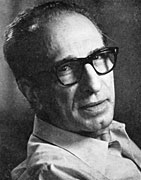
Onofrio Pacenza was born in Buenos Aires, on May 6, 1904. He studies architecture and interior design and is accepted in the Academia Nacional de Bellas Artes. In 1928, he gets his Artistic Drawing degree. He teaches the following courses at said institution, Artistic drawing, Composition and Painting. He also teaches Geometry and Drawing Art at the Escuela Nacional de Bellas Artes "Manuel Belgrano". He goes on a study trip to Europe. He forms part of the group Pintores Modernos sponsored by the Asociación Amigos del Arte (1930-1940) and later Amigos del Libro (1946-52). In 1960 he is invited to participate at the Exposición del Sesquicentenario de la Revolución de Mayo.
He takes part in many exhibits abroad, among them we find: Mostra di Pittura Argentina, Rome, Milan, Venice and Genova (1937); International Exhibitions in New York, Los Angeles, Richmond and California (1941); Muestra Internacional de la UNESCO, Paris (1946); Muestra de la Pintura Argentina en el Estado de Israel (1952); VI Bienal de San Pablo (1961). He is invited by the Academia Nacional de Bellas Artes in 1965 to participate in the Palanza Prize and in 1968 in the Tres Arroyos Prize.
He receives many awards throughout his career, among them we can find: First Prize and Gold Medal at the Salón Nacional in 1960; First Prize and Gold Medal at the Salón de la Marina Argentina in 1962; Honor Award by the Ministerio de Educación and Gold Medal at the Salón Nacional in 1963. In 1965 his paintings take part in an 11 minute short film, consisting of an audiovisual presentation that gathers Argentine plastic artists, with music by Aníbal Troilo and reflections about the suburbs, with texts written by Ernesto Sábato. Together with the work of Pacenza we can find Carlos Alonso, Juan Carlos Castagnino, Héctor Basaldúa, Víctor Rebuffo, Raúl Soldi and Carlos Torrallardona. Sábato also wrote the lyrics of Alejandra, a tango with music by Pichuco and whose theme Pacenza painted on canvas.
He dies in Buenos Aires, on June 27, 1971.
His work can be found in the following museums: Museo Nacional de Bellas Artes and Museo de Artes Plásticas “Eduardo Sívori”, both in Buenos Aires; Museo de Arte Latinoamericano in Los Angeles and Richmond, USA; Pinacoteca del Quirinale in Rome and the Museo Nacional de Venezuela. His work is also shown in museums of Chile and Tel Aviv. We can also find his work in local and international private collections.